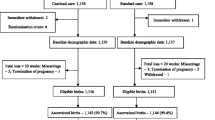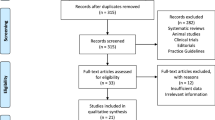Abstract
Objectives
To review evaluations of changes in the delivery of antenatal care for Australian Indigenous women and the impact on care utilization and quality, birth outcomes and women’s views about care.
Methods
Seven databases were searched electronically for articles describing evaluations of antenatal care programs developed for Australian Indigenous women. Manual searches were performed of the publication sections of websites of Australian Government Departments responsible for health and Indigenous affairs.
Results
Evaluations of 10 antenatal care programs were identified. Wide variations were present in the design, quality and reported outcomes of each evaluation. There was a lack of consistency in the findings across all care programs for many outcomes. Modest increases were reported for measures of care utilization, including the proportion of women initiating care in the first trimester and the mean number of antenatal visits overall. For birth outcomes, benefits were reported by some but not all care programs for perinatal mortality, preterm birth, mean birth weight and the proportion of low birth weight infants. Of the four care programs reporting women’s views about care, most comments were positive reflections about care, including the use of female staff and the continuity of care providers.
Conclusions
The impact of the antenatal care programs evaluated and published to date remains inconclusive. Limitations arose from the diversity in the design of evaluations and the quality of reported data. This review has highlighted the need for good quality long-term data collection about the health services providing antenatal care for Australian Indigenous women.

Similar content being viewed by others
Notes
Figures refer to births to Indigenous mothers, not all Indigenous births.
The Source for Online Australasian Information, \(\copyright\) Informit, RMIT Publishing.
References
Carroli, G., et al. (2001). WHO systematic review of randomised controlled trials of routine antenatal care. Lancet, 357, 1565–1570.
Australian Bureau of Statistics (ABS), Australian Institute of Health and Welfare (AIHW). (2004). The health and welfare of Australia’s Aboriginal and Torres Strait Islander peoples. ABS Catalogue No. 4704.0. Canberra: Commonwealth of Australia.
Stewart, M. L., & Li, S. Q. (2005). Northern territory midwives collection: Mothers and babies 2000–2002. Northern Territory, Department of Health and Community Services.
Day, P., et al. (1999). Indigenous mothers and their babies Australia 1994–1996. AIHW Cat. No. PER 9. Perinatal Statistics Series No. 8. Sydney: Australian Institute of Health and Welfare National Perinatal Statistics Unit.
de Costa, C., & Child, A. (1996). Pregnancy outcomes in urban aboriginal women. The Medical Journal of Australia, 164(9), 523–526.
Mackerras, D. (1998). Evaluation of the Strong Women, Strong Babies, Strong Culture Program: Results for the period 1990–1996 in the three pilot communities. Issue No. 2/98. Darwin, Northern Territory. Menzies Occasional Papers.
Powell, J., & Dugdale, A. E. (1999). Obstetric outcomes in an aboriginal community: a comparison with the surrounding rural area. The Australian Journal of Rural Health, 7(1), 13–17.
Australian Health Ministers Advisory Council, Standing Committee on Aboriginal and Torres Strait Islander Health Working Party. (2004). Cultural respect framework for Aboriginal and Torres Strait Islander Health. South Australia: Department of Health.
The Cochrane Library (2006). Issue 1 [On-line]. Accessed February 20th 2006 at http://www.3.interscience.wiley.com/cgi-bin/mrwhome/106568753/HOME.
Watson, D. S. (1985). The use of ultrasound scanning by Aboriginal health workers in antenatal care in a remote area of Australia. Medical Journal of Australia, 143(9 Suppl), 61–63.
Carter, E., et al. (2004). ‘Alukura... for my daughters and their daughters and their daughters’. A review of Congress Alukura. Australian and New Zealand Journal of Public Health, 28(3), 229–234.
Daruk Aboriginal Community Controlled Medical Service. (1998). Evaluation of the Daruk Antenatal Program 1998. Sydney: Daruk Aboriginal Medical Service and Western Public Health Unit.
Jan, S. et al.(2004). An holistic economic evaluation of an Aboriginal community-controlled midwifery programme in Western Sydney. Journal of Health Services Research & Policy, 9(1), 14–21.
Hunt, J. (2003). Trying to make a difference, improving pregnancy outcomes, care and services for Australian Indigenous women, PhD Thesis, Latrobe University, Faculty of Health Sciences, School of Public Health, Victoria.
Hunt, J. (1996). Gumileybirra women’s health service, the story so far. Northern Territory: Danila Dilba Medical Service.
Hunt, J., et al. (1996). Gumileybirra Women’s Health Project, Danila Dilba Biluru Butji Binnilutlum Medical Service, Darwin, NT. In G. Robinson (Ed.), Aboriginal health, social and cultural transitions: proceedings of a conference at the Northern Territory University, Darwin, 29–30th September 1995 (pp. 70–76). Darwin: NTU Press.
Panaretto, K. S., et al. (2005). Impact of a collaborative shared antenatal care program for urban Indigenous women: a prospective cohort study. The Medical Journal of Australia, 182(10), 514–519.
Atkinson, R. (2001). Antenatal care and perinatal health—How to do it better in an urban Indigenous community. Paper presented at the 6th national rural health conference, 4–7th March 2001, Canberra, Australian Capital Territory.
Sloman, D. (1999). Obstetrics and child health outcomes on the Anangu Pitjantjatjara Lands, 1984–1996: A preliminary analysis. Paper presented at the 5th national rural health conference, 14–17th March 1999, Adelaide, South Australia.
Dorman, R. (1997). Ngua Gundi (mother and child) program. Aboriginal and Islander Health Worker Journal, 21(5), 2–6.
Perkins, S. (1996). My future in your hands: the Ngua Gundi [Mother/Child] Project 1993–1996. Queensland: Queensland Health.
Perkins, S., Simon, S. (2000). The Ngua Gundi (Mother/Child) Project 1997–2000. Queensland: Queensland Health.
Smith, R. M. et al.(2000). Birthweights and growth of infants in five Aboriginal communities. Australian and New Zealand Journal of Public Health, 24(2), 12–135.
Mackerras, D. (2001). Birthweight changes in the pilot phase of the Strong Women Strong Babies Strong Culture Program in the Northern Territory. Australian and New Zealand Journal of Public Health, 25(1), 34–40.
Tursan d’Espaignet, E., et al. (2003). Monitoring the ’Strong Women, Strong Babies, Strong Culture Program’: The first eight years. Journal of Paediatrics and Child Health, 39, 668–672.
Fejo, L., & Rae, C. (1995). Strong Women, Strong Babies, Strong Culture Project, 1992–1994. Northern Territory: Territory Health Services.
Campbell, S., & Brown, S. (2003). The women’s business service at the Mildura Aboriginal Health Service. A descriptive evaluation study October–November 2002. Victoria: Centre for the Study of Mother’s and Children’s Health.
Campbell, S., & Brown, S. (2004). Maternity care with the women’s business service at the Mildura Aboriginal Health Service. Australian and New Zealand Journal of Public Health, 28(4), 376–382.
Nel, P., Pashen, D. (2003). Shared antenatal care for Indigenous patients in a rural and remote community. Australian Family Physician, 32(3), 127–131.
Koori Health Unit. (1996). Koori Pilot Birthing Service Projects. Victoria: Department of Human Services, Koori Health Unit.
Koori Health Unit. (1996). Providing services to Koori women having a baby. Victoria: Department of Human Services, Koori Health Unit.
Mencshelyi, C. (2003). Ngunytju Tjitji Pirni (NTP). Aboriginal and Islander Health Worker Journal, 27(5), 15–16.
Eades, S. (2004). Maternal and child health care services: actions in the primary health care setting to improve the health of Aboriginal and Torres Strait Islander women of childbearing age, infants and young children. Canberra: Department of Health and Ageing.
New South Wales (NSW) Health. (2003). The NSW Aboriginal perinatal health report. North Sydney, NSW: Department of Health.
New England Health. (1998). Aboriginal Maternity Service Report January–June 1998. New South Wales: New England Health.
Jarrett, J., et al. (1998). Djuligalbhan 1993–1996 Report. New South Wales: Durri Aboriginal Corporation Medical Service.
Nichols, B., & Hurley, J. (1999). The aboriginal maternity service, Tamworth. Aboriginal and Islander Health Worker Journal, 23(4), 24–28.
Herceg, A. (2005). Improving health in Aboriginal and Torres Strait Islander mothers, babies and young children: A literature review. Canberra: Department of Health and Ageing.
Hunt J. M., & Lumley J. (2002). Are recommendations about routine antenatal care in Australia consistent and evidence-based?. The Medical Journal of Australia, 176, 255–259.
Cunningham, J. (2006). Diversity of primary health care providers for urban Indigenous Australians. Australian and New Zealand Journal of Public Health, 30(6), 580–581.
Paradies, Y, & Cunningham, J. (2002). Placing Aboriginal and Torres Strait Islander mortality in an international context. Australian and New Zealand Journal of Public Health, 26(1), 11–16.
Bramley D, Hebert P, Jackson R, & Chassin M. (2004). Indigenous disparities in disease-specific mortality, a cross-country comparison: New Zealand, Australia, Canada, and the United States. The New Zealand Medical Journal, 117(1207), U1215.
Acknowledgements
AR is supported by a National Health and Medical Research Council (NHMRC) Population Health Capacity Building Grant (No. 236235), which provides funding for the Capacity-building in Indigenous Policy-relevant HEalth Research (CIPHER) Program. The CIPHER program is recognised as an in-kind contribution to the Co-operative Research Centre for Aboriginal Health (CRCAH). JC is supported by a NHMRC Career Development Award (No. 283310).
Author information
Authors and Affiliations
Corresponding author
Rights and permissions
About this article
Cite this article
Rumbold, A.R., Cunningham, J. A Review of the Impact of Antenatal Care for Australian Indigenous Women and Attempts to Strengthen these Services. Matern Child Health J 12, 83–100 (2008). https://doi.org/10.1007/s10995-007-0216-1
Received:
Accepted:
Published:
Issue Date:
DOI: https://doi.org/10.1007/s10995-007-0216-1




